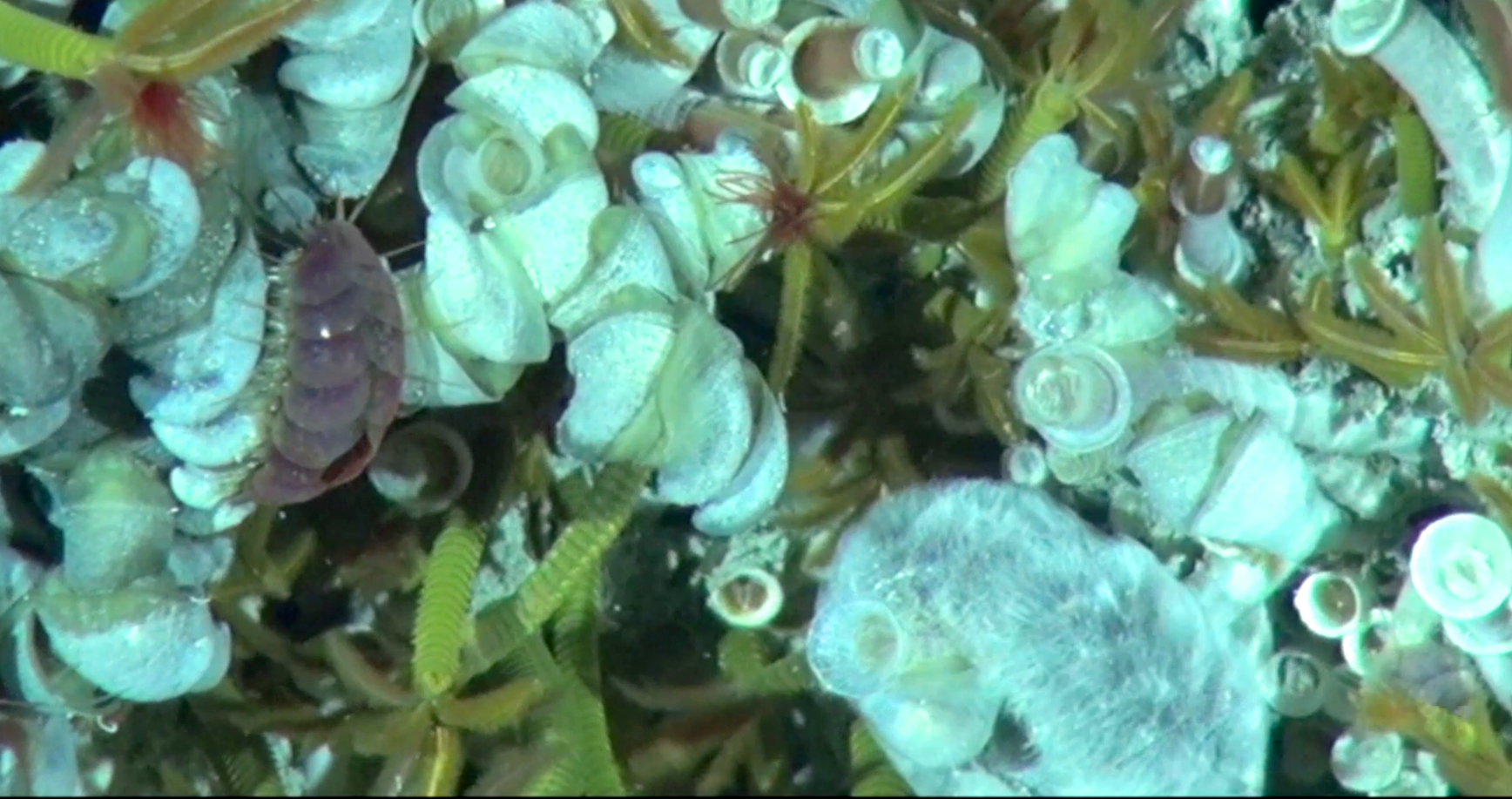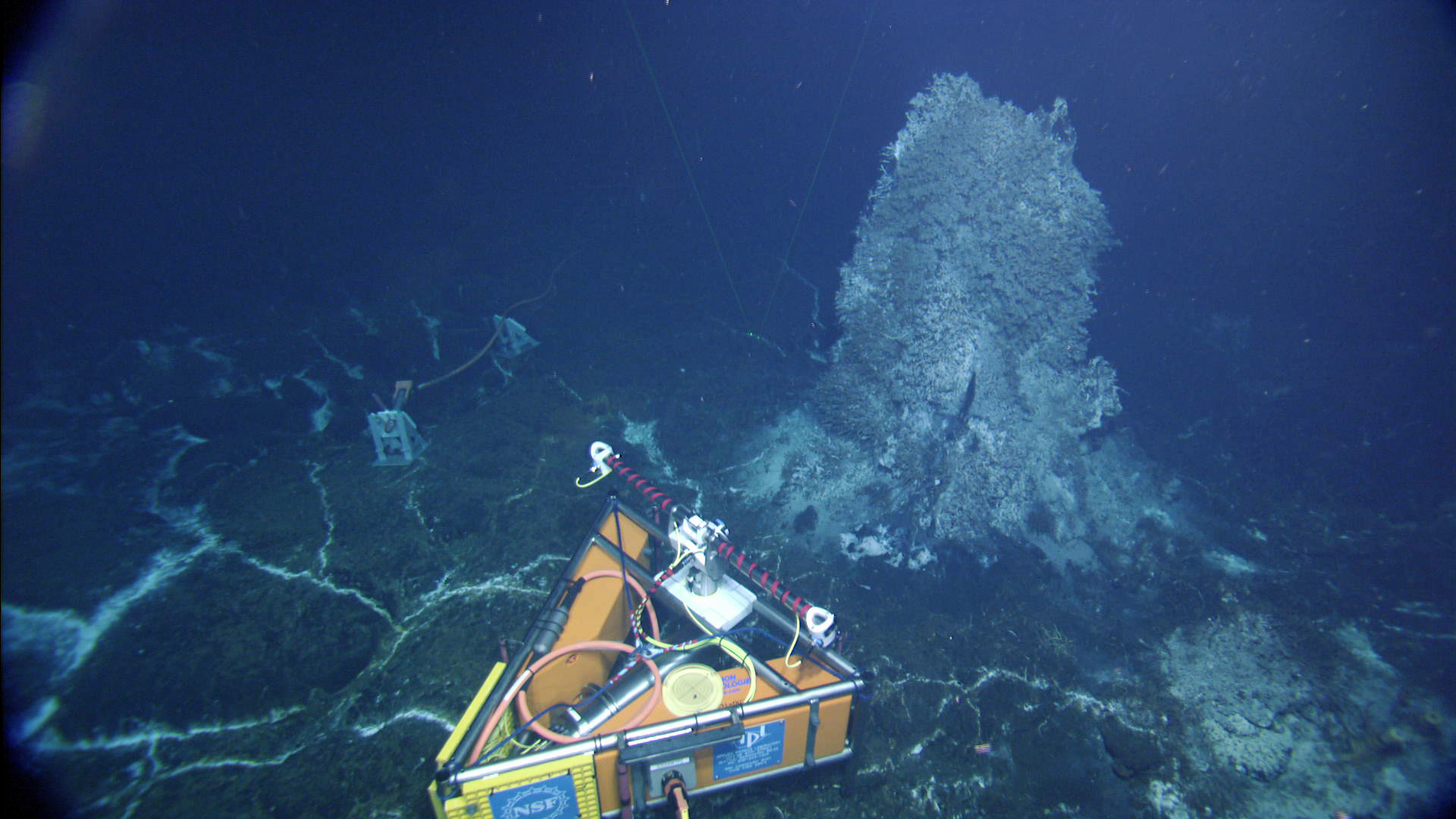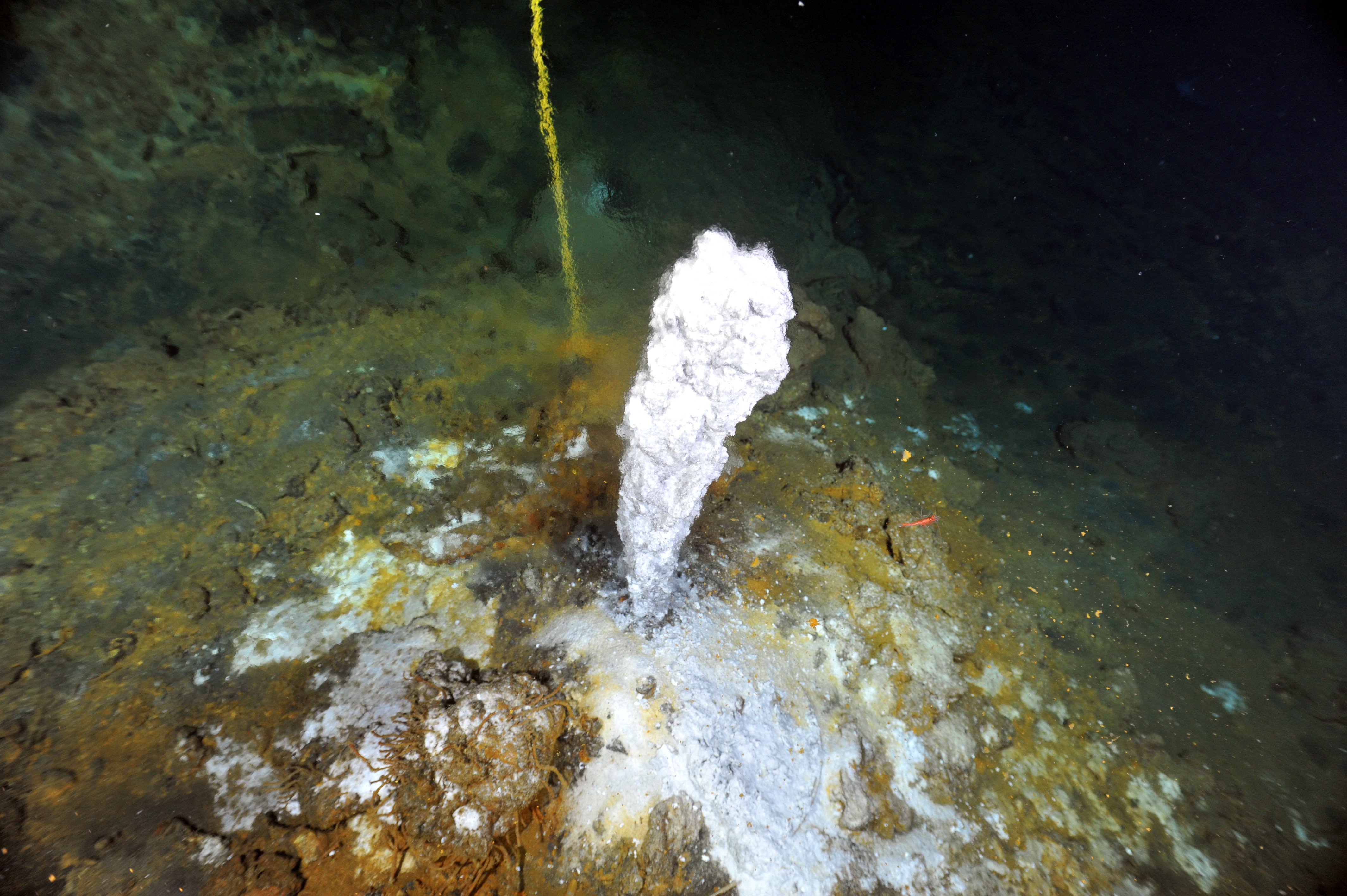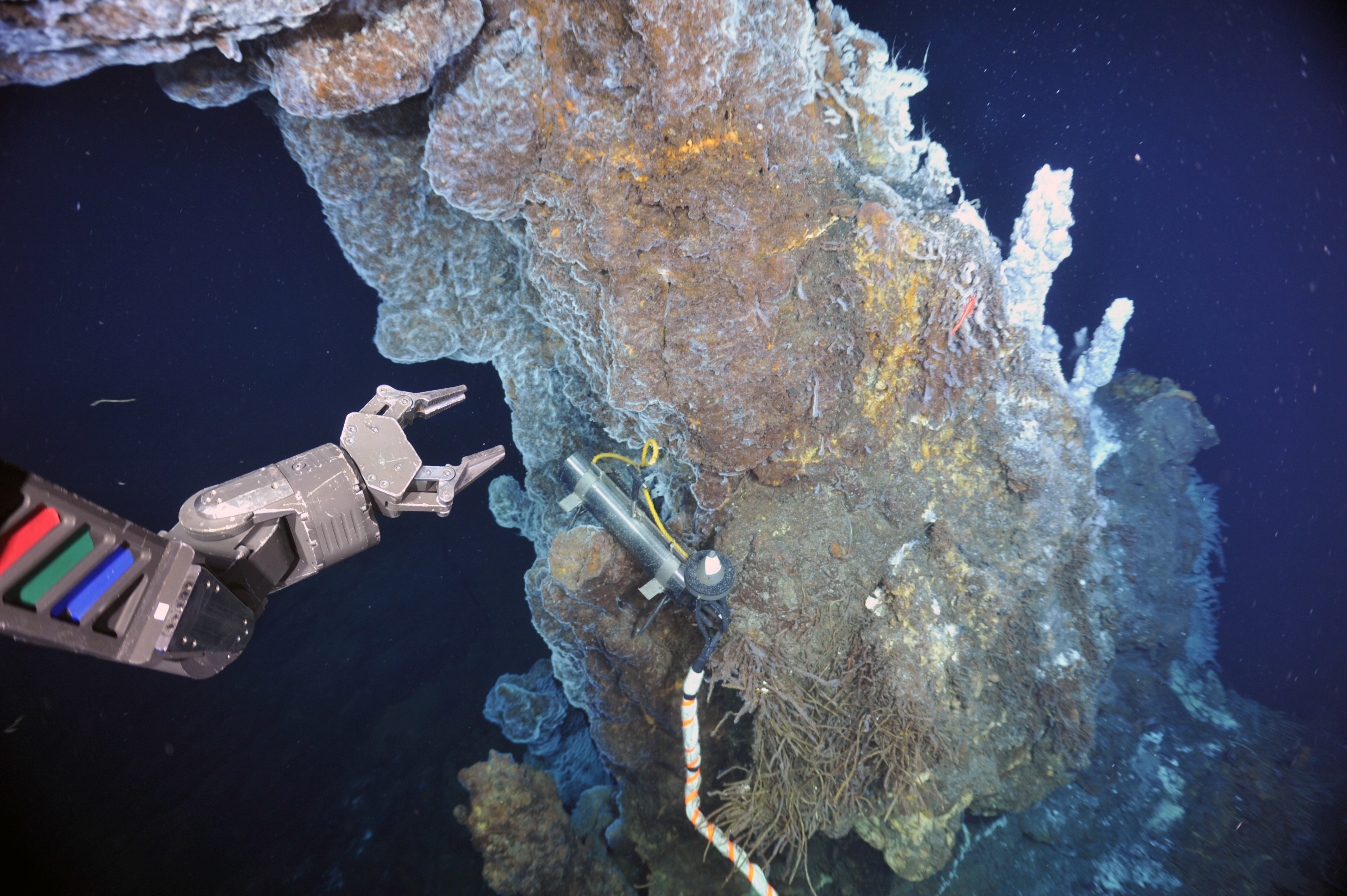Image Archive





























Two scaleworms roam among the Palm worms and limpets at Mushroom, one of the hydrothermal vents at ASHES vent field on Axial Seamount. One worm shows its usual pinkish red color (at left), while the other is coated with a fur-like layer of filamentous bacteria. This image was taken with the RCA HD Video Camera during its test on the seafloor during VISIONS 13. Credit: UW/NSF-OOI, V14

During the VISIONS'13 Expedition, three subnets were completed at this site (highlighted in blue). They include: 1) a medium-powered J-box MJ03B in the ASHES hydrothermal field, which is connected to two short-period seismometers; 2) an HD camera also in the ASHES hydrothermal field; and 3) a medium powered J-box MJ03E connected to two short-period seismometers. Over 20 km of extension cables, with lengths up to ~ 5 km, were successfully installed in 2013 using the ROV ROPOS. All extension cables and subnets were fully tested and are functional, awaiting to be connected to Primary Node PN3B. The remaining infrastructure will be deployed in during VISIONS'14, next year.

The RCA high definition camera at the base of the hydrothermal vent called Mushroom. Credit: UW/NSF-OOI/CSSF; ROPOS Dive R1636; V13.

During VISIONS'13 two types of flow meters (CAT and Mosquito) were deployed at the summit of Southern Hydrate Ridge near the Einstein's Grotto active seep site - each instrument has specific ranges of flow that they measure. They will be recovered in 2014, providing year-long records of flow into and out of the sediment. Credit: UW/OOI-NSF//CSSF; V13

During ROPOS Dive 1611, the ROV latched into the remotely operated cable laying system (ROCLS) hosting a drum with an RSN extension cable ready to be installed. In concert, these two systems successfully installed >22,000 m of extension cables on the seafloor during the UW-OOI-NSF VISIONS'13 expedition.

The ROV team, SN scientists and engineers, and UW students gather in the operations laboratory aboard the R/V Thompson during Dive 1605 to Southern Hydrate Ridge during the VISIONS'13 Expedition. Photo Credit. Mitch Elend, University of Washington.

With ROPOS's heavy lift capabilities and industry style latch system on its underbelly, it is able to safely take heavy loads to the seafloor. During the VISIONS'13 Expedition, ROPOS takes two short-period seismometers to the seafloor in the tool basket at the start of Dive 1617 to the caldera of Axial Seamount.

During the UW-OOI-NSF VISIONS'13 Expedition, the remotely operated vehicle ROPOS installed three medium power J-Boxes (secondary nodes) utilizing their special 4,000 lb heavy lift capabilities. ROPOS took this RSN J-Box down on dive R1601. The broad feet on the J-Box are used for installation in heavily sedimented areas. This was an unusually calm day at sea in the NE Pacific. Photo Credit: Mitch Elend, University of Washington.

The team photo for Leg 4 on one of the forward decks of the R/V Thompson. The hills outside of Victoria BC are in the background.

A dolphin streams ahead of the R/V Thompson as the ship transits home from 47 days at sea. Credit: Cody Turner, University of Washington, V13.

The students on Leg 4 gather on the bow of the R/V Thompson. From left to right - Charlie Parker, Andrew Baird, Vega Shaw, Cody Turner, Caitlin Russell, Teos Bisbee, Brendan Philip, and Colin Katagiri....oh,and to the far right is 'Mr. Chicken,' a fine member of the science party who was the only one to dive to 5000 ft beneath the oceans surface. During the VISIONS'13 program, 20 undergraduate and graduate students participatied in the sea-going experience onboard the R/V Thompson using the Canadian ROV ROPOS.

Before and after images of the fantail of the R/V Thompson during the VISIONS'13 expedition - at the end of the cruises there was nothing else left to deploy.

The ~ 4 m tall chimney called Inferno in the ASHES hydrothermal field sprouts a very young (< 2 year old) fragile beehive. The beehive structure is composed of very fine-grained sulfide minerals and anhydrite. Lush assemblages of tube worms, palm worms and limpets grow on the outer walls of the edifice. VISIONS '13, LEG 4. Photo credit: NSF-OOI/UW/CSSF

The Diva hydrothermal vent, is a 277°C small, fragile anhydrite (CaSO4) structure in the International District vent field on Axial Volcano. The chimney is of interest because it has the highest carbon dioxide concentrations of any of the chimneys within the Axial caldera. In 2014, it will host an instrument developed by Dr. Bill Seyfried, University of Minnesota, that will provide real-time streaming data on acidity, hydrogen sulfide, hydrogen and temperature of the vent fluids. VISIONS '13, Leg 4. Photo credit: NSF-OOI/UW/CSSF

A short-period seismometer (OBSSPA301) is installed ~1.3 km east of the ASHES hydrothermal field. A cable connects to a medium power junction box in the field. During testing with ROPOS, this seismometer recorded a small earthquake. Credit: UW/NSF-OOI/CSSF, ROPOS Dive R1640; V13.

A resistivity-temperature probe, developed by Dr. Marv Lilley at the University of Washington, was deployed into a 270°C actively venting orifice on the chimney called Escargot. Resistivity is an analogue for chlorinity. Some of the vents in the International District are boiling, causing release of very gas-rich, low-salinity fluids. This instrument, recovered on ROPOS dive 1638, was deployed on a small ledge on the structure a few weeks previously with power provided by batteries in the titanium housing. The orange-white taped cable leads to the wand that is inserted into the chimney (not shown in this image). The white, feathery material on the outside of the chimney is filamentous bacteria, supported by low-temperature diffuse fluids that waft up the side of the chimney. Photo credit: NSF-OOI/UW/CSSF

An Argo Float just being released from the R/V Thompson during the VISIONS'13 program. It will collect chemical measurements to depths of 1000 m, surfacing every 5-10 days to transmit these data back to shore via a satellite. Photo Credit: Mitch Elend, University of Washington.

University of Washington, School of Oceanography undergraduate student - Charlie Parker- deploys an Argo float over Axial Seamount during the VISIONS'13 program. The float wil submerge to 1000 m beneath the surface, taking chemical measurements along the way, and every 5-10 days will surface and transmit these data over a satellite to shore. Photo Credit: Mitch Elend, University of Washington.

Charlie watches an Argo Float drift past the R/V Thompson following his deployment of it 200 m northeast of the Primary Node location for the Regional Scale Nodes program. We are especially anxious to see the results of the ISUS nitrate sensor on it as it makes measurements above Axial Seamount. Photo Credit: Mitch Elend, University of Washington.

Many of the days on site during VISIONS'13 were overcast with calm seas...perfect for diving.

The summit of this hydrothermal chimney, called 'Eascargot', has a striking resemblance to a snail. A 270°C actively venting site (two small white chimneys mid structure) will host a cabled temperature-resistivity sensor there in 2014. This sensor will provide real-time data on the fluid chemistry (chlorinity) -temperature relationships inside the vent. The instrument was designed by Marv Lilley, University of Washington. VISIONS '13, Leg 4. Photo credit: NSF-OOI/UW/CSSF

Brendan and Giora analyze gases in hydrothermal fluids from the chimneys called 'Diva' and 'Escargo' in the International District Hydrothermal Field on Axial Volcano. The fluids are sampled using highly specialized tiranium water samplers to collect 'gas tight' samples, and analyzed onboard the Thompson using a gas chromatograph. Photo Credit: Deborah Kelley, University of Washington.

Brittle stars of the species Spinophiura jolliveti are very abundant on all the lava rocks at Axial Seamount within the caldera. Photo credit: NSF-OOI/UW/CSSF.

This short-period seismometer was deployed on a flat sheet flow ~ 1.3 km east of the ASHES hydrothermal field in 2013. The black ball in the yellow circle shows that it is perfectly level, helping to insure that the highest quality data comes off of this network. Axial Volcano is likely to be quite seismically active and we are anxious to get the real-time data on shore next year. This will help us understand magma and fluid migration in the subsurface of the volcano...and eventually these data may help us predict an eruption. Several earthquakes were detected in real-time during testing of these seismometers in 2013. Credit: UW/NSF-OOI/CSSF, ROPOS Dive R1635; V13.

Paul gives a tour of the T/V Thompsons engine room to VISIONS'13 students.

Inside the ROV ROPOS control room, the science and engineering team watches in amazement at the life that thrives around the hydrothermal vents. Here, microbial experiements are being recovered from the structure Mushroom using the 7 manipulator function arm of ROPOS. The experiments will be used by Harvard graduate student H. Olins to study the metabolisms of microbes in these extreme environments. Photo Credit: Caitlin Russell, Boston University.

Caitlin looks at a microbial experiment brought up from hydrothermal diffuse flow site at the base of the chimney called Mushroom: water depth ~ 5000 ft. Photo Credit: Mitch Elend, University of Washington.

High-temperature, near-boiling fluids jet from small spigots on the top of the metal-sulfide, black-smoker chimney called El Guapo (the handsome one) in the International District Hydrothermal Field. VISIONS '13, Leg 4. Photo credit: NSF-OOI/UW/CSSF
- Anemone
- Animal
- Arthropod
- ASHES
- Axial
- Axial Base
- Axial Biology
- Axial Caldera
- Bacteria
- Basalt Lava
- BEP
- Biofouling
- biolgoy
- Biology
- Camds
- Camera
- Camhd
- Central Caldera
- Ciliates
- Cnidaria
- Coastal Biology
- Crab
- Deep Profiler Mooring
- Dive Highlights
- Eastern Caldera
- Echinoderms
- Endurance Array
- Engineering Team
- ENLIGHTEN 10
- Exploratorium
- Fish
- Geology
- HD Camera
- HPIES
- Hydrate Ridge
- Hydrates
- Hydrophone
- Hydrothermal Vents
- Illustration
- Inshore 80 Meters
- Instrument
- International District
- J-BOX
- Jason
- Jellyfish
- Junction Box
- K12
- Lava
- Mollusk
- Moorings
- Nodes
- Nudibranch
- Octopus
- OOI
- Oregon Offshore
- Oregon Offshore 600 m
- Oregon Shelf
- Oregon Slope Base
- People
- PN1B
- PN1D
- Polychaetes
- PPSDN
- Primary Node
- RASFL
- ROCLS
- ROPOS
- ROPOS Dives
- ROV Team
- RV Revelle
- RV Sikuliaq
- RV Thompson
- Salp
- Sample
- SC13
- Science Team
- Sea Cucumber
- Sea Star
- Sea Urchin
- Seafloor
- Seismometer
- Sensors
- Shallow Profiler Mooring
- Shark
- Shipboard
- Shore Station
- Slope Base
- Smoker
- Soft Coral
- Southern Hydrate Ridge
- Sponge
- Squid
- Students
- Students & Guest Participants
- Tmpsf
- Tubeworms
- VISIONS 11 Leg 1
- VISIONS 11 Leg 2
- VISIONS 11 Viewers
- VISIONS 13
- VISIONS 14
- VISIONS 15
- VISIONS 16
- VISIONS 17
- VISIONS 18
- VISIONS 20
- VISIONS 22
- VISIONS 23
- Visualization
